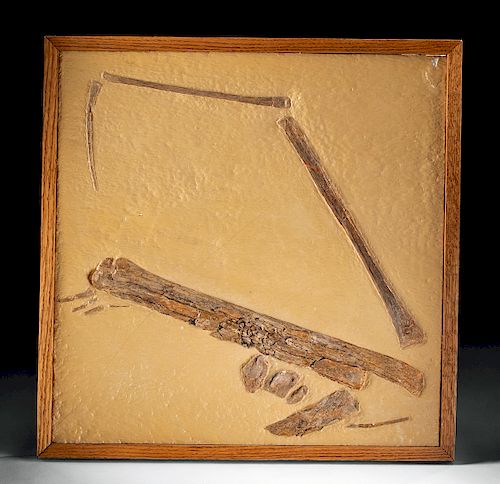Kansas Late Cretaceous Fossilized Pterodactyl Wing
Lot 114a
About Seller
Artemis Fine Arts
686 S Taylor Ave, Ste 106
Louisville, CO 80027
United States
Selling antiquities, ancient and ethnographic art online since 1993, Artemis Gallery specializes in Classical Antiquities (Egyptian, Greek, Roman, Near Eastern), Asian, Pre-Columbian, African / Tribal / Oceanographic art. Our extensive inventory includes pottery, stone, metal, wood, glass and textil...Read more
Estimate:
$5,000 - $7,500
Absentee vs Live bid
Two ways to bid:
- Leave a max absentee bid and the platform will bid on your behalf up to your maximum bid during the live auction.
- Bid live during the auction and your bids will be submitted real-time to the auctioneer.
Bid Increments
| Price | Bid Increment |
|---|---|
| $0 | $25 |
| $300 | $50 |
| $1,000 | $100 |
| $2,000 | $250 |
| $5,000 | $500 |
| $10,000 | $1,000 |
| $20,000 | $2,500 |
| $50,000 | $5,000 |
| $100,000 | $10,000 |
| $200,000 | $20,000 |
About Auction
By Artemis Fine Arts
Oct 3, 2019
Set Reminder
2019-10-03 10:00:00
2019-10-03 10:00:00
America/New_York
Bidsquare
Bidsquare : Exceptional Day 2: Pre-Columbian & Tribal Art
https://www.bidsquare.com/auctions/artemis-gallery/exceptional-day-2-pre-columbian-tribal-art-4453
Day 2 of an important 2-day auction featuring exceptional, museum-worthy examples of Pre-Columbian from the ancient Americas, Native American, African / Tribal, Oceanic, Spanish Colonial and fossils. Artemis Fine Arts info@artemisfinearts.com
Day 2 of an important 2-day auction featuring exceptional, museum-worthy examples of Pre-Columbian from the ancient Americas, Native American, African / Tribal, Oceanic, Spanish Colonial and fossils. Artemis Fine Arts info@artemisfinearts.com
- Lot Description
North America, Gove County, Kansas, Niobrara Formation Smoky Chalk, Late Cretaceous Period, ca. 80 to 65.5 million years ago. A beautiful pterodactyl wing from Pteranodon longiceps, displayed with 16 bones articulated in a frame. If unfurled, the wing would be nearly 4 feet long! The pteriod (bone found only in pterosaurs, connecting the wrist to support the propatagium, the membrane structure of the wing) and all 4 phalanxes (wing finger) are present. Size: 22.2" W x 22.75" H (56.4 cm x 57.8 cm)
Pterosaurs, flying reptiles who lived in the vicinity of the Western Interior Sea that occupied what is now the American midwest during the late Cretaceous, were the first vertebrates to fly. They had hollow, air-filled bones, membranous wings supported by the elongated fourth finger of each hand, and a fused upper skeletal system that supported the huge muscles they used to power their wings. They also had large, bird-like brains and were presumably quite intelligent animals. They ranged in size from about that of a modern robin to the massive Quetzalcoatlus whose wingspan was comparable to that of a Cessna! Many of their remains have been found in the Smoky Hill Chalk of western Kansas, which would have been hundreds of miles from the nearest shoreline (near to present-day Denver), suggesting that the massive creatures migrated across the sea.
Provenance: private J.H. collection, Beaverton, Oregon, USA
All items legal to buy/sell under U.S. Statute covering cultural patrimony Code 2600, CHAPTER 14, and are guaranteed to be as described or your money back.
A Certificate of Authenticity will accompany all winning bids.
We ship worldwide and handle all shipping in-house for your convenience.
#150137The fossils are embedded in the matrix, and the matrix and the fossils have all been painted with a stabilizing coat. Professionally prepared with some small areas of restoration and some small losses; the fossil appears to be about 80-90% original material.Condition
- Shipping Info
-
All shipping is handled in-house for your convenience. Your invoice from Artemis Gallery will include shipping calculation instructions. If in doubt, please inquire BEFORE bidding for estimated shipping costs for individual items.
-
- Buyer's Premium



 EUR
EUR CAD
CAD AUD
AUD GBP
GBP MXN
MXN HKD
HKD CNY
CNY MYR
MYR SEK
SEK SGD
SGD CHF
CHF THB
THB
















